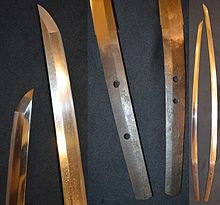Your Cart is Empty


Worn by samurai warriors in feudal Japan, the tachi is a curved single-bladed sword. It was actually the predecessor to the katana, sharing many of its counterpart's characteristics. Furthermore, the tachi paved the way for the uchigatana, which was a longer and heavier variation of the sword.
Origins of the Tachi
The tachi can be traced back to the Japan's Koto period.
In " The Connoisseur's Book of Japanese Swords," author Kōkan Nagayama explains that the first authentic tachi were forged before 1596, making it one of the island nation's oldest sword types. Originally, the tachi was forged with a lighter and thinner blade. When the Mongols invaded Japan in 1274, however, swordsmiths transitioned to a thicker and heavier design for greater stopping power.
The Mongols exposed a weakness in Japan's army: thin-bladed swords which proved ineffective at cutting through armor. To overcome this weakness, Japanese swordsmiths began forging the tachi with stronger and thicker blades.
Samurai warriors often preferred the tachi when on horseback due to its combination of strength, durability and agility. Of course, swordsmiths crafted several variations of the sword, including short, medium and long-length blades.
According to Wikipedia, the longest tachi measures approximately 12 feet long with a 7' 3" blade! Classified as a 15th century odachi, it wasn't used for fighting, but rather it was used for ceremonial purposes. With a blade more than a foot taller than the average person, it was simply not practical to use on the battlefield.
Of course, the development of the katana resulted in the decline of the tachi. Towards the end of the Koto period, Japanese swordsmiths converted many of the country's tachi into katanas by cutting their original tangs and eliminating the signature. This allowed the swordsmiths to "repurpose" the tachi instead of simply disposing of it.
How to Distinguish Between a Tachi and Katana
Because of their striking similarities, many people struggle to differentiate between the traditional Japanese katana and the tachi. If you measure the length of the blades, however, you'll notice the standard tachi is slightly longer at 70-80 centimeters compared to the katana's 60-73.
You can also tell the difference between a tachi and katana by looking for the signature. The tachi would typically feature a signature carved into the tang, facing outward when the sword is worn on the waist. Furthermore, the tachi was worn on the waist with the cutting edge facing down, whereas the katana was worn with the cutting edge facing up.